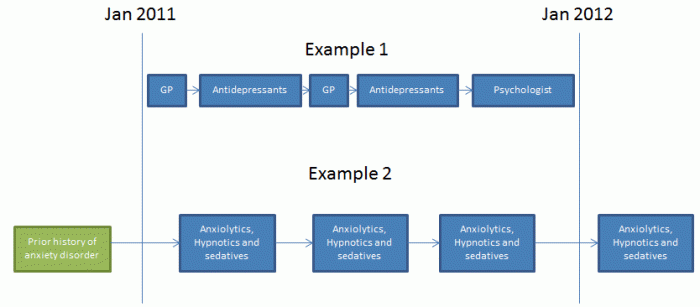This publication is the second in a series of analyses based on data from the Mental Health Services-Census Integrated Dataset. It further explores patterns of use of Medicare Benefits Schedule (MBS) subsidised mental health-related services and Pharmaceutical Benefits Scheme (PBS) subsidised mental health-related medications in 2011, building upon the first release of information in Characteristics of People using Mental Health Services and Prescription Medication, 2011 (cat. no. 4329.0).
Individual types of service use (e.g. consultations with psychologists) and medications (e.g. antidepressants) are considered in more detail, in conjunction with the number of mental health-related consultations and prescriptions Australians accessed in 2011. Combinations of types of treatments are also considered, while logistic regression modelling has been used to identify the likelihood of a person transitioning from services to medications and vice versa. In the Integrated Dataset, the Census of Population and Housing provides insight into a range of socio-demographic characteristics including age, sex, remoteness, socio-economic disadvantage, household income, labour force status, educational attainment and others.
Mental health-related treatments in Australia
People seeking assistance in managing or treating mental health conditions in Australia may have a number of options available to them. The particular option(s) a person follows may be influenced by a range of factors, such as their diagnosis, the severity of the condition, treatment options available as well as personal preference. Options, for example, can include community based services, hospital-based care, Commonwealth subsidised treatments through the Medicare Benefits Schedule (MBS) and Pharmaceutical Benefits Scheme (PBS), on-line facilities (such as those available from beyondblue) and telephone counselling services (such as Lifeline Australia).
Mental health-related treatments included in this publication refer to MBS subsidised mental health-related services and/or PBS subsidised mental health-related medications only.
Mental health-related services provided by the following five groups are included:
- Psychiatrists;
- General Practitioners;
- Clinical Psychologists;
- Other Psychologists; and
- Other Allied Health Professionals.
Mental health-related medications for the following four groups are included:
- Antipsychotics;
- Anxiolytics/Hypnotics and sedatives;
- Antidepressants; and
- Psychostimulants, agents used for ADHD and nootropics.
See Appendix 1 and Appendix 2 respectively for more detail about specific mental health-related services and medications listed on the MBS and PBS and covered in this analysis.
The following examples illustrate two possible treatment options and are included to demonstrate how such treatments would be reflected in the Integrated Dataset used for this analysis:
Image

Description
In Example 1, a person attends their GP and explains they have been feeling down recently. After discussion, the GP prescribes antidepressants and arranges for a subsequent consultation in two months. At this second consultation the person explains they are still feeling down, and therefore the GP prescribes a different antidepressant as well as referring the person to a psychologist. In the Mental Health Services-Census Integrated Dataset this person would therefore have three MBS subsidised mental health-related services in 2011 and two PBS subsidised mental health-related medications.
In Example 2, a person was diagnosed with an anxiety disorder prior to 2011 which is being managed with ongoing medication. This person would therefore have had an MBS subsidised mental health-related service prior to 2011, three PBS subsidised mental health-related medications in 2011, and a further prescription in 2012.
Data quality considerations
There are a number of factors that should be considered when interpreting information presented in this publication.
While the MBS items included in analysis include a range of subsidised mental health-related services provided in Australia, consultations with some medical practitioners such as paediatricians were not captured in the Mental Health Services-Census Integrated Dataset, even if they were related to mental health. Consultations with GPs that may have involved discussion of mental health issues but were not recorded as mental-health related services were also not captured.
Additionally, people who accessed mental health-related medications in 2011 for whom no mental health-related service was recorded in 2011 should not be considered to have obtained the medication without a prescription; rather, the consultation at which the medication was prescribed may not have been recorded as a mental health-related service, or may have occurred earlier than 2011.
Finally, while the four groupings of medications included in analyses are commonly prescribed for treating mental health conditions, they may also be prescribed to treat other conditions. A person's use of mental health-related services or medications does not imply a diagnosis of a mental health condition. For information on people who reported having a mental or behavioural condition in Australia in 2014-15 (4.0 million people) see National Health Survey: First Results, 2014-15 (cat. no. 4364.0.55.001).